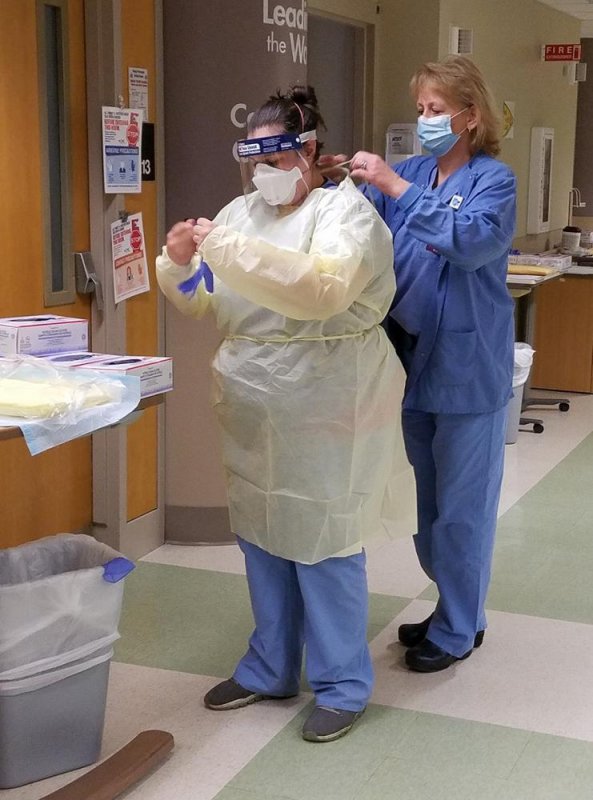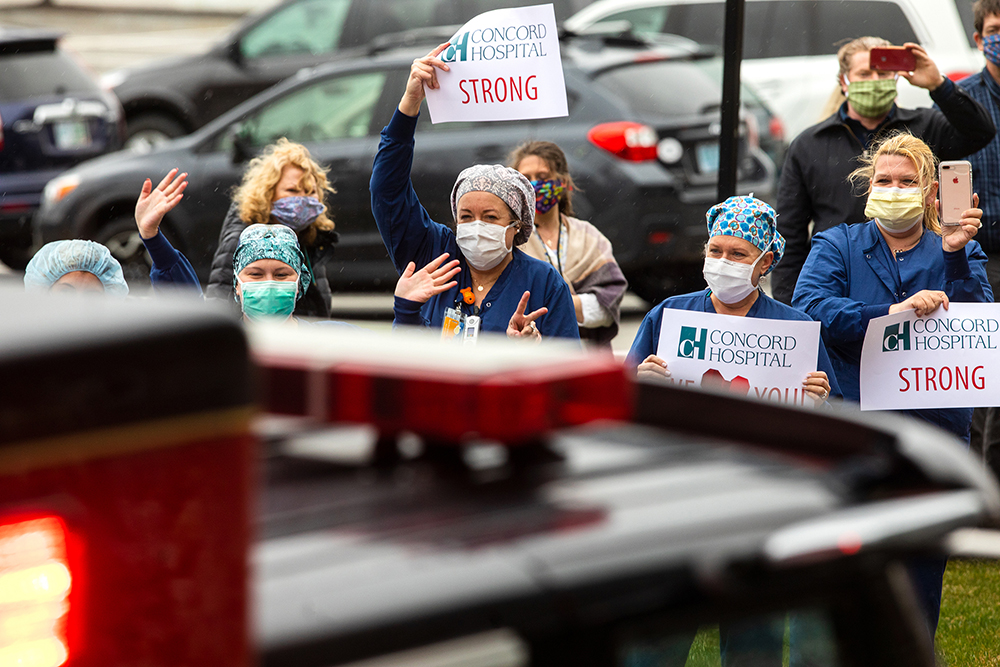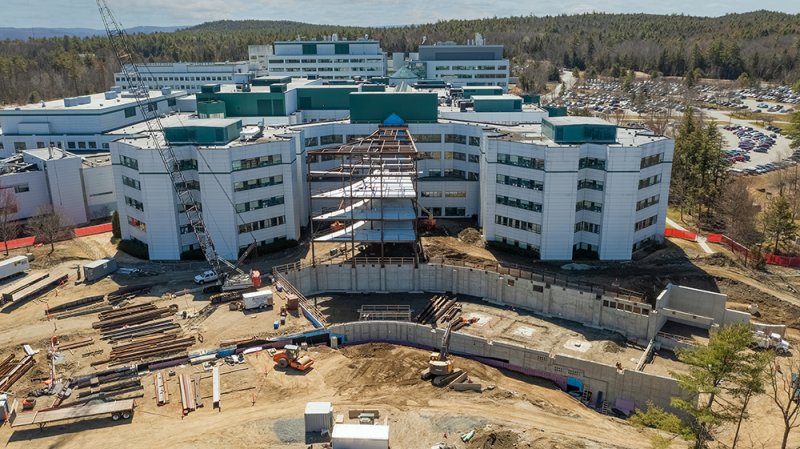
When the coronavirus pandemic hit NH, the state’s hospitals were the first line of defense, but their efforts came at an enormous financial cost from which they are still reeling.
New Hampshire’s hospitals lost an estimated $480.6 million in revenue between March and December of last year, resulting in $151.4 million in COVID-19-related losses, according to the NH Hospital Association. LRGHealthcare—already ailing before the outbreak—was forced to file for bankruptcy before accepting an acquisition bid from Concord Hospital.
Most hospital administrators, though, anticipate a slow return to normalcy and foresee no further bankruptcies in the near future. They also predict the pandemic will permanently change everything from hospital design to patient visitation procedures. And they fear a future glut of patients who are seriously ill because they postponed routine screening procedures and an increase in the already underserved population of those with mental health or substance abuse issues.
The state has 13 large community hospitals with a total of 2,715 beds, 13 critical access hospitals with 336 beds, and five specialty hospitals with 576 beds, and all were affected by the pandemic.
“COVID has had a devastating financial impact on CMC [Catholic Medical Center] and hospitals throughout New Hampshire and the country,” says Alex Walker, CMC president. In FY 2020, his organization lost $47 million, despite $24 million in state and federal relief, and furloughed 1,300 employees, most of them now back.

Emergency Department staff at Catholic Medical Center donning protective gear. Courtesy photo.
“It’s like nothing I’ve ever experienced in my 42 years in health care,” agrees Kevin J. O’Leary, CFO at Exeter Hospital, which saw an operating loss of about $20.6 million in fiscal 2020, even after $10.3 million in federal relief grants. The first five months of this fiscal year ended with $3.4 million in operating losses, despite another $2.6 million in relief funds.
Hospital executives say the pandemic hit them with a double whammy—decreased revenues as they were forced to eliminate all but emergency and time-sensitive procedures during a month-and-a-half state-ordered shutdown, and increased costs as they had to buy machinery and special equipment to keep staff and patients safe and hire additional personnel like door screeners and security guards.
CMC spent nearly $1 million on personal protective equipment, says Walker, and $2 million in pandemic-related equipment like scrubbers, licenses for screeners, overtime and payment for traveling nurses.
Even before COVID, “most hospitals in New Hampshire were running on a pretty razor-thin margin,” notes Dr. Greg Baxter, president of Elliot Health System. His organization last year had been projecting a 4% profit margin, and instead barely finished in the black, largely thanks to money from the federal CARES (Coronavirus Aid, Relief, and Economic Security) Act.
“On a $600 million budget, we were less than 1%,” he adds. Last spring, Elliot Hospital was treating 40-50% of the COVID admissions in the state, Baxter says, and the government directed much of the relief effort to facilities with high numbers of pandemic-related patients.
Rescuing LRGH
COVID proved too challenging for LRG-Healthcare, which included Lakes Region General Hospital, Franklin Regional Hospital and the hospitals’ ambulatory sites. The organization filed for bankruptcy in October, after which Concord Hospital acquired its assets—an arrangement that was approved by state regulatory agencies.

Concord Hospital staff cheering on passing emergency vehicles in front of the hospital. Geoff Forester/Concord Monitor.
LRGHealthcare’s financial worries predate the arrival of COVID. Former LRGH President and CEO Kevin W. Donovan, who is now chief administrative officer for Concord Hospital Laconia and Franklin, says it had just three and a half days of reserve on hand when he started five years, but the pandemic “hastened the bankruptcy” by dropping revenues and increasing expenses, he says.
At the time of the bankruptcy filing, LRGH had $150 million of debt it couldn’t service, says Donovan, owing to “a long period of declining financial performance and making some investments that were maybe a little too large in facilities and electronic medical records and funding with some private physician organizations.”
Scott Sloane, senior vice president and CFO for Concord Hospital, says his organization purchased LRGHealthcare’s assets for $30 million, taking on its pension obligation of between $15 million and $17 million and is providing tail insurance coverage against potential malpractice suits.
“We looked at their service area, and we share a lot of patients,” he says. “We didn’t want that organization to fail because of the void it would leave in the marketplace.” Sloane says Concord Hospital did not acquire LRGH to grow its own footprint. It acquired them “so care can remain in the community. It’s mission first, not about growing Concord Hospital,” he says.
Sloane says Concord Hospital has a long track record of good financial performance, maintaining an operating margin of 2 to 3% for more than 25 years. Still, it too was hard-hit by the pandemic. The shutdown in March and April produced operating losses of $32 million, but the decision was made not to lay off any staff. “We were able to ramp back up our volume close to pre-pandemic levels by July,” he says. That was helped by $29.5 million in federal stimulus funds.
COVID Modifications
Forgoing elective and non-emergency procedures for a month and a half was the biggest revenue reducer hospitals faced because of COVID, all agree. But medical facilities were also forced to modify protocols and physical spaces—all at a cost—at the same time.
Steve Ahnen, president of the NH Hospital Association, outlines some of those measures: setting up incident command centers, adding staff and security, modifying visitation procedures, moving patients to telehmedicine formats, adding capacity by converting non-patient rooms into ones that could be used for patients, and struggling in a competitive market to secure ventilators, personal protective equipment and other items needed to protect staff and patients.
Some hospitals also purchased new filtration or ventilation systems to allow for negative pressure rooms, where air is sucked out of a space so that potential infectious agents are prevented from entering other areas.
Susan Reeves, executive vice president of Dartmouth-Hitchcock Medical Center in Lebanon, says her facility had just convened some work groups early last year to tackle issues like inadequate bed capacity, workforce shortages and an “off-target” operating margin when “boom, ‘close it down’ was the mandate.”
With lost revenue from cancelled non-emergency procedures and a wave of patients needing a high level of care around the holidays, the hospital was far from the 2% or 3% margin it enjoyed two years ago. Officials agreed a “break-even” approach to the 2021 operating budget was reasonable but exceeded that slightly.
John A. Jurczyk, president of St. Joseph Hospital in Nashua, says his organization was slightly below the break-even point financially in 2019 but at the height of the pandemic started losing an average of $2 million a week. With 75% of revenues coming from outpatient visits, the state-ordered shutdown in March and April was disastrous, and St. Joseph was forced to furlough 270 employees, most of whom are now back, Jurczyk says.
Though St. Joseph Hospital received some federal assistance “right out of the gate” in April, Jurczyk says the relief spigot was turned off for the next few months because the hospital didn’t serve the same percentage of COVID patients as those in the I-93 corridor or otherwise didn’t meet CARES Act guidelines. “We would miss out on funding because either we did not serve a certain segment of the population or didn’t have a disproportionate share of Medicaid patients, or we were not classified as a rural hospital,” he says.
The hospital turned to the state and congressional delegation and late in the year was awarded more than $12 million in federal funds. Thanks to those monies, “we ended up the year slightly positive,” Jurczyk says. The first two months of this year, however, saw operating losses of about $1.1 million, he adds.
Tom Mee, CEO of North Country Healthcare, an affiliation of four medical facilities in the state’s White Mountain region, says the state and federal relief that rural hospitals received was especially important because “40% of rural hospitals nationwide were already losing money prior to COVID.”
 A North Country Healthcare drive-thru COVID vaccine clinic. Courtesy photo.
A North Country Healthcare drive-thru COVID vaccine clinic. Courtesy photo.
His organization was “skating by on razor-thin margins” of 1-2% even before the pandemic came along, but stimulus money allowed it to cover costs and still have some left for facilities, he says. “I don’t know how long the stimulus money is going to last,” Mee adds.
Unique Challenges
On top of COVID-related losses, hospitals continue to face financial challenges that other institutions do not.
Of NH’s 31 hospitals, 24 are nonprofit. “We are open 24/7, and we care for everyone who crosses the threshold, regardless of their ability to pay, regardless of whether they have insurance, regardless of their financial status,” Walker of CMC says.
Federal reimbursements for Medicare and Medicaid patients—which include those over 65, disabled and low-income—do not even cover costs, and the NH Hospital Association says unreimbursed Medicare costs for NH hospitals were $330.5 million in 2018, the most recent year for which figures are available. Unreimbursed Medicaid costs were $262.7 million.
In addition, the most recent federal stimulus package includes no relief funding for hospitals despite losses that Ahnen calls “simply unsustainable.”
“We will continue to work with our state partners and federal delegation to secure future funding relief to support hospitals as they navigate this public health crisis,” he says.
A Second Wave
Across the state, as nationally, patient volume post-COVID continues to be down, both cutting into revenues and stirring concerns that those who have put off care due to COVID will later flood medical facilities, possibly with more acute illnesses.
“I think we’re going to see a second wave of patients come in a year or two, and they’re going to be those patients who ignored primary care during the pandemic and they’re going to be sicker than they would have been,” says Mee. “They’re going to test a system that would have contracted because of COVID.”
Jurczyk at St. Joseph Hospital says the “case mix index”—a measure of the severity of an illness—has skyrocketed at his facility, “meaning that when patients are admitted, they’re extremely ill. The fear of coming to the hospital, the fear of going to a doctor’s office, the willingness to defer care until it’s too late, we’re seeing a lot of late-stage presentation.”
Donovan reports that emergency room volume at LRGHealthcare’s facilities is down by 20% and “surgical visits are down 10% or more. You’re finding a lot of people still avoiding care because they’re still being conservative, or they’re afraid to go to a hospital setting.”
O’Leary at Exeter Hospital says, “At the aggregate level, the drop in patients has been an equal opportunity employer. We have seen drops in Medicare beneficiary patients, commercial insurance patients, Medicaid patients, self-pay patients.”
“This hasn’t been a rainy day. It’s been a rainy year,” adds Mark Whitney, vice president for strategy, community relations and advancement at Exeter Hospital.
COVID also eclipsed what many call “the other pandemic” that was taking a toll long before COVID-19: mental health and substance abuse disorders that may have been exacerbated by the coronavirus threat.
“This pandemic has really spiked in terms of kids and adults suffering from mental health and behavioral health crises,” says Whitney, adding that just that day Exeter Hospital’s emergency department had six patients facing mental health crises—“a substantial increase” from normal.
Reeves of Dartmouth-Hitchcock Medical Center, likewise, says, “With the lack of access to mental health services during the pandemic, we are now seeing that other epidemic really flare again and it’s worse.”
“It is the forgotten pandemic,” agrees Jurczyk, who says on that day he had more patients in his emergency department awaiting psychiatric placement than he had COVID patients.
With the pandemic improving, hospital administrators say they look forward to a more coordinated approach to treating behavioral health.
Hope on the Horizon
The pandemic has left many hospitals rethinking their financial priorities. “We have a strong balance sheet. COVID won’t bankrupt our organization,” says O’Leary. “We won’t close because of it, but what could occur, depending on how long it takes this organization to get back to a break even position and a more profitable position, it could have impacts on some of the decisions we make relative to services we offer and investments in other ambulatory sites.”
But many see a rebound in sight. “We’re finally starting to get back to some semblance of normal,” says Walker. “Vaccine distribution has been spiritually and emotionally uplifting, but it’s making a real difference. As the rollouts have increased, I feel like we’re, for the first time, starting to outpace the virus.”
That’s good news not only for hospitals but for the communities they serve, notes O’Leary. “The hospital is usually the single largest employer within a service area,” he says. “Take Exeter [Hospital] with 2,800 employees. They lead departments, they buy houses, they consume based on their household needs. If they have to start to shrink and reduce, that’s going to have an economic burden on those communities and the state of New Hampshire in total.”
Hospital administrators agree the pandemic also underscored some of the strengths of NH’s health care facilities: their ability to adapt to unexpected challenges nimbly and their willingness to collaborate for the greater good. “Hospitals in New Hampshire work well together, certainly in times of crisis,” says Sloane.
Reeves at Dartmouth-Hitchcock says she has “never been so proud to be a member of the hospital community. The contract we have with each other is no one individual hospital would be under water to meet patient needs if other hospitals had the capacity to help.”
When the Elliot Hospital needed six ventilators last spring, Baxter says, other hospitals quickly provided them. If one facility ran out of emergency room beds, says Jurczyk, others absorbed those patients.
COVID Reshaping Health Care
All agree COVID will result in long-term changes to how health care is conducted and even how hospitals are designed in NH, including waiting room layouts, increased use of private rooms, more negative pressure rooms and heavier reliance on telemedicine.
“If someone was building a hospital now, I would anticipate people are thinking about air circulation, filtration, negative pressure and the ability to physically or socially distance in ways they haven’t previously,” says Dr. Christopher Fore, associate chief clinical officer for hospital-based practices at Concord Hospital. “We never thought about negative pressure in an ambulatory area. Now these things will be critical.”
Telemedicine has proven convenient not only for keeping patients isolated but for those who live some distance from the hospital, especially in inclement weather, he adds. Despite concerns over whether insurance companies will continue to reimburse telemedicine visits at the same rate as in-person ones, such remote visits are here to stay, he says.
Sloane says the COVID-prompted practice of having people wait in their cars instead of in waiting rooms before appointments is gone but will affect design in the future. “These are all going to be thought about for future design. How can we not aggregate people?” he says.
At CMC, where officials postponed a multi-million-dollar expansion project in partnership with Dartmouth-Hitchcock because of COVID, teams are now working together on a pandemic-informed design for the new facility, with groundbreaking planned for next year.
“This expansion will have private inpatient rooms, and that’s a game-changer for patients on a number of levels, not the least of which is infection prevention,” says Walker. “We’re going to create a space that’s flexible so if we have to convert to different isolation areas, we can.… We are approaching the design of this new facility with an eye to the future and having learned lessons from COVID.”
Elliot Hospital already obtained approval for an emergency room expansion when COVID hit, according to Baxter, and “we adjusted some of the design because of the pandemic,” he says. It will feature ultraviolet treatment of air, more negative pressure rooms and rooms spaced farther apart.
Further north, Dartmouth-Hitchcock is taking a similar approach to the design of its 212,000-square-foot expansion, which will feature private rooms with negative air pressure, according to Reeves.

Construction of Dartmouth-Hitchcock’s patient pavilion. Courtesy photo.
Preparedness, administrators agree, is critical. “Woe to us as an industry, across the whole country, if we don’t learn from this, if we think this is going to be the one and only virus that starts to cause problems with humanity once every hundred years,” says O’Leary. “We had better be prepared for the second time around because there will be a second time around.”

 Current Issue - April 2024
Current Issue - April 2024